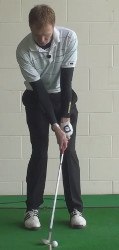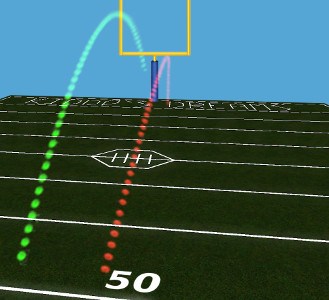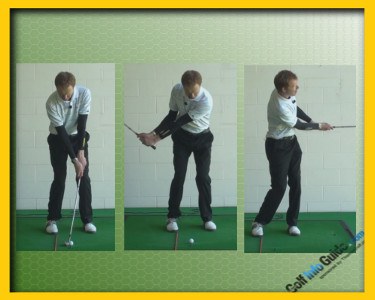
Pro golfers hit such pretty shots around the greens – high, spinning pitches that check up and trickle to within inches of the hole. When amateurs try to emulate their heroes, however, the results are often ugly.
Too many golfers are guilty of scooping chip and pitch shots in a futile attempt to lob them high into the air. The typical result is either a fat or thin shot which either comes up well short or skitters past the cup.
In most cases, low is the way to go. Provided there's no hazard or other obstacle between you and the hole, try to get the ball on the green and running as quickly as possible. This requires hitting the ball with the club traveling downward, pinching ball against turf with a crisp “thunk.” The shot will fly close to the ground and begin rolling soon after landing.
A few basics are necessary to keep the ball down:
1) Set up with the ball in the center of your stance and the hands pushed just ahead of the ball.
2) Place a little extra weight on your left (lead) side.
3) Keep the hands ahead of the clubhead into and past impact.

This drill will give you a feel for hitting low chips and pitches, and teach you why scooping doesn't work:
- On the range, set up to play a 40-50 yard pitch.
- Imagine a pair of goal posts between you and the target; you must hit the ball under the crossbar using the method described above.
- Next, try hitting the ball high over the crossbar. Did you make solid contact? Or did you flip the wrists trying to slip the club underneath the ball?
Continue experimenting with different swing styles to change shot trajectories. You'll learn which techniques are effective, and which ones cause mishits.

Crisp Chip Shot Golf Drills – Lower is Better?
Chipping is a portion of the game that seems to plague amateur golfers perhaps more than any other. While plenty of players struggle off the tee or on the greens, you can probably find the most complaints from average players regarding their chipping and pitching skills. Since this is a kind of shot that comes up frequently, struggling to chip the ball well is a difficulty that is likely to add many strokes to your score. If you want to find the fastest way to become a better golfer, look no further than this area of your short game.
In this article, we are going to highlight some chipping drills which should help you strike the ball more crisply. Specifically, we are going to address low chip shots. Are low chip shots the best option in many cases, and how do you hit them? We will get to those questions, and more, in the content that follows. If you have not previously thought much about your chipping game and how to optimize its performance, we hope these discussions will elevate your play in short order.
Why is chipping so important? Some simple math can provide you with an accurate answer. As an amateur golfer, it is unlikely that you hit even half of your greens in regulation. The top pros usually come in somewhere between 65% - 75%, and you almost certainly aren't playing to that standard. Let's give you the benefit of the doubt and say that you are able to hit half of your greens. That's nine out of every eighteen holes, of course. This means you will be chipping nine times during the course of a round. Your success or failure with those nine chip/pitch shots will go a long way toward determining your score at the end of the day.
For instance, imagine you are a mid-handicap golfer who often records scores in the mid-80s. In a normal round, you get up and down just twice out of nine tries, and you shoot an 84. What if you could improve that percentage? If you had a round where you got up and down seven out of nine times, you would suddenly shoot a 79! That is a huge difference just based on the quality of your short game. The numbers won't always work out like this, obviously, but you get the idea. Adding a few yards to your tee shots probably won't have much of an impact on your scores, but learning how to chip more accurately certainly will. Spend time improving your chipping performance and it is a certainty that your scores will start to move in the right direction.
All of the content below is based on a right-handed golfer. If you happen to play left-handed, please take a moment to reverse the directions as necessary.

The Benefits of Lower Chip Shots
Before we get into the chipping drills you can use to improve your play, let's take a moment to talk about why it is so beneficial to chip the ball low. The concept of chipping low is lost on most amateur golfers, as the typical player thinks first and foremost about hitting the ball high up into the air. This may be because they think that pro golfers hit their chip shots high as well – but that is not the case. Sure, a pro player will need to hit a high chip shot from time to time depending on the circumstances, but those shots are the exception rather than the rule. Most of the time, a pro will gladly keep the ball down close to the ground whenever possible.
The biggest benefit of chipping the ball low is consistency. It is simply more consistent to play low shots from around the green than it is to hit high shots. When you hit a low shot, you have a few advantages working in your favor which will benefit your consistency. Those advantages are as follows –
- Margin for error. When you try to hit a high chip shot, you have to catch the ball perfectly at the moment of impact in order to succeed. If you miss-hit the shot even slightly – hitting it a bit fat or thin, for example – you will be left with a poor result. That is not the case when you take the low path. When playing a low chip shot, there is some margin for error built in to the equation. You still want to hit the ball cleanly, of course, but a miss-hit will not be punished as severely as it would when trying to go high. For instance, if you hit a low chip shot a bit heavy, the ball might come up a little short of the hole in the end – but it should still be a playable result. Hit the ball heavy when trying to hit a high shot, however, and you might fail to even reach the green. We can all benefit from added margin for error in our golf games, so don't take this point for granted.
- No need to predict the spin. One of the hardest parts of playing a high chip shot is predicting the effect that the spin is going to have on your shot when it lands. All chip shots have some amount of backspin, so figuring out what that spin is going to mean for the shot is an important task. Will the ball take just one bounce and stop quickly, or will the spin only slow it down slightly? Guessing what the backspin on your shot is going to do to the ball is never a perfect science, even for an experienced player. There are simply too many variables involved to get it right each and every time. Fortunately, you can get around this problem by playing low chip shots instead. With a low chip shot, there will be very little backspin involved, meaning you can count on the ball taking a relatively 'normal' bounce and roll. You might get a bit too much check from time to time, but that will be the exception and not the rule. Generally speaking, low chip shots don't need to be planned with backspin in mind.
- Less chance to get it badly wrong. This is an important point when it comes to hitting chip shots under pressure. If you try to hit a high chip shot, there will always be a chance that the shot could go terribly wrong. You need to make a bigger swing to hit the ball high as opposed to low, and that bigger swing means more energy will be involved at the moment of impact. If too much of that energy is passed either into the ball or into the ground, a poor shot will be the result. A thin shot will go shooting across the green, and a fat shot will be left at your feet. When you are nervous, these negative scenarios tend to play over and over in your head. To stay away from such pressure, opt for low shots that are far less likely to go wrong. Your chip shots still won't be perfect each time, of course, but that's okay. As long as you avoid particularly bad shots, you can set yourself up with at least a chance to make a putt and complete the up and down.
As you are already aware, it will simply be impossible to play low chip shots in every situation. Sometimes, the golf course dictates that you need to go high. When those situations arise, you will have to call on your experience and preparation to play the best possible shot. However, when you do have a choice, it is wise to keep the ball down closer to the earth. For the reasons mentioned above, this is a smarter way to go about the short game.

Drill #1 – A Downward Strike
To hit crisp, solid, low chip shots, you are going to need to hit down on the ball. That is not a point which is up for debate – it is just a fact of life on the golf course. Unfortunately, many players go wrong starting with this very basic point. If you can't hit down, you are never going to be able to chip with the kind of consistency required to play good golf. Therefore, we are going to start our list of three drills with a simple drill that will help you establish the proper angle of attack in your short game.
The step-by-step instructions below will take you through the process of completing this drill.
- For the drill, you are going to need a few items. You will need a pitching wedge, a few golf balls, some golf tees, and a place to practice. It is perfectly acceptable to use this drill with clubs other than the pitching wedge, but the pitching wedge is a good place to start. Go ahead and experiment with other wedges after you get the hang of it.
- Set yourself up at the chipping green in the practice area of your local course. You should be standing in a position that provides you with a clean, flat lie on fairway-length grass. It is important to learn how to chip from difficult positions, but now is not the time for such work. Instead, you want to give yourself the best possible lie so this drill can work correctly.
- Place the first ball down on the ground in front of you and pick out a target hole on the green. Again, this should be a very easy shot. Before you take your stance to hit the first shot, you are going to take one of your golf tees and push it into the ground behind the ball. The tee should be just a couple inches behind the ball, on an extension of the target line. You are going to push the tee most of the way into the turf, but the very top – where the ball would rest if you were using the tee normally – will still be above the ground just slightly.
- You are now ready to hit your first shot. Based on the setup of this drill, the idea should be obvious – you are going to hit the chip shot while trying to swing down over the tee on your way into impact. This will be impossible to accomplish unless you hit down properly. If you 'sweep' the club along the top of the grass and into the back of the ball, you are going to make contact with the tee and your shot will be thrown off.
Regardless of your level of success, hit at least a few shots within this setup before stopping to think about how it is going. Are you able to swing through cleanly, or do you keep hitting the tee? How do these shots feel when coming off your club? It may be necessary to experiment with technical changes until you are able to consistently miss the tee and send solid chip shots up toward the target.
This is an extremely simple chipping drill, yet it is one of the best for learning how to strike the ball cleanly. Once you have a crisp, clean strike on your side, you will be able to predict your distances with much greater consistency than ever before.






